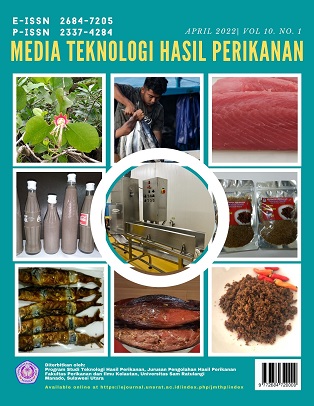Karakteristik Mutu Bakso Ikan Tuna dengan Penambahan Tepung Agar-Agar
DOI:
https://doi.org/10.35800/mthp.10.1.2022.38729Abstract
The quality of fish balls is one of the indicators used in the food industry, this study aims to analyze the best quality of tuna fish balls with the addition of gelatin flour by increasing the analysis of water content, ash content, crude fiber content and organoleptic. The method that will be used in this research is descriptive exploratory with 4, namely the addition of agar-agar flour (T0), the addition of 6g of gelatin flour (T1), the addition of 8g of agar-agar flour (T2) and the addition of 10g of agar-agar flour (T3 ). The results of data analysis showed that the addition of agar-agar flour was able to improve the quality of tuna fish balls, the addition of 10g agar-agar flour was the best treatment with a round and neat shape of meatballs with a distinctive smell of tuna and jelly with a strong gel texture and does not break when folded, water content is 72.57%, ash content is 0.62%, crude fiber is 29.61%.
Keywords:Â Â Â Tuna fish balls, water content, ash content, crude fiber, organoleptic, gelatinous flour.
Â
Peningkatan mutu bakso ikan merupakan salah satu indikator yang digunakan dalam industri pangan, penelitian ini bertujuan menganalisis karakteristik mutu terbaik bakso ikan tuna dengan penambahan tepung agar-agar dengan menganalisis kadar air, kadar abu, kadar serat kasar dan organoleptik. Metode yang akan digunakan dalam penelitian ini adalah deskriptif eksploratif dengan 4 perlakuan yaitu tanpa penambahan tepung agar-agar (T0), penambahan tepung agar-agar 6g (T1), penambahan tepung agar-agar 8g (T2) dan penambahan tepung agar-agar 10g (T3). Data hasil analisis menunjukkan bahwa penambahan tepung agar-agar mampu meningkatkan mutu dari bakso ikan tuna, perlakuan penambahan tepung agar-agar 10g merupakan perlakuan yang terbaik dengan bentuk bakso yang bulat dan rapi dengan aroma bau khas ikan tuna dan agar-agar dengan tekstur gel yang kuat dan tidak patah bila dilipat, kadar air 72,57%, kadar abu 0,62%, serat kasar 29,61%.
Kata kunci:Â Bakso ikan tuna, kadar air, kadar abu, serat kasar, organoleptik, tepung agar-agar.
References
Ardianti, Y., Widyastuti, S., Rosmilawati, & Handito, D. (2018). Pengaruh Penambahan
Karagenan Terhadap Sifat Fisik dan Organoleptik Bakso Ikan Tongkol (Euthynnus affinis).
JURNAL ILMIAH ILMU PERTANIAN, 159-166.
Hapsari, A., & Upahita, D. (2021, Juni 25). Kementrian Kesehatan Republik Indonesia. Diambil
kembali dari Hello Sehat.com: https://hellosehat.com/nutrisi/tips-makan-sehat/cara-
mencukupi-kebutuhan-serat-harian/
Kusharto, C. M. (2006). Serat Makanan dan Perannya Bagi Kesehatan. JURNAL GIZI DAN
PANGAN, 45-54.
Musa, K. H., Aminah, A., & Wan-Aida, W. M. (2005). Effects of cryoprotectants on functional.
Malaysian Applied Biology, 83-87.
Puspita, D. A., Agustini, T. W., & Purnamayati, L. (2019). Pengaruh Perbedaan Kosentrasi Garam
Terhadap Kadar Asam Glutamat Pada Bubuk Bekasam Ikan Lele(Clarias batracus). Jurnal
Teknologi Pangan, 110-115.
Santoso, J., Trilaksani, W., Nurjanah, & Nurhayati, T. (1997). Perbaikan Mutu Gel Ikan Mas
(Cyprinus carpio) melalui Modifikasi Proses. JURNAL PENGOLAHAN HASIL
PERIKANAN INDONESIA.
Simanjuntak, D. H., Lumingas, L. J., & Sangari, J. R. (2019). Potensi Lestari Perikanan Tangkap
Tuna di Sekitar Perairan Provinsi Sulawesi Utara Berdasarkan Data Pelabuhan Perikanan
Samudra (PPS) Bitung, Sulawesi Utara). Jurnal Perikanan dan Kelautan Tropis.
Sipahutar, Y., Ma’roef, A., Febrianti, A., Nur, C., & Utami, S. (2016). Penambahan Konsentrasi
Tepung Karagenan pada bakso ikan Tuna (Thunnus sp). JURNAL TEKNOLOGI DAN
PENELITIAN TERAPAN, 1410-7694.
Wibowo, S. (1995). Bakso Ikan dan Bakso Daging. Jakarta: Penebar Swadaya.
Yakhin, L. A., Wijaya, K. M., & Santoso, J. (2013). Peningkatan Kualitas Gel Sosis Ikan Lele
dengan Penambahan Tepung. JURNAL PENGOLAHAN HASIL PERIKANAN INDONESIA,
NO. 2.
Downloads
Published
How to Cite
Issue
Section
License
Authors who publish with this journal agree to the following terms:
- Authors retain copyright and grant the journal right of first publication with the work simultaneously licensed under a Creative Commons Attribution License that allows others to share the work with an acknowledgement of the work's authorship and initial publication in this journal.
- Authors are able to enter into separate, additional contractual arrangements for the non-exclusive distribution of the journal's published version of the work (e.g., post it to an institutional repository or publish it in a book), with an acknowledgement of its initial publication in this journal.
- Authors are permitted and encouraged to post their work online (e.g., in institutional repositories or on their website) prior to and during the submission process, as it can lead to productive exchanges, as well as earlier and greater citation of published work (See The Effect of Open Access).







